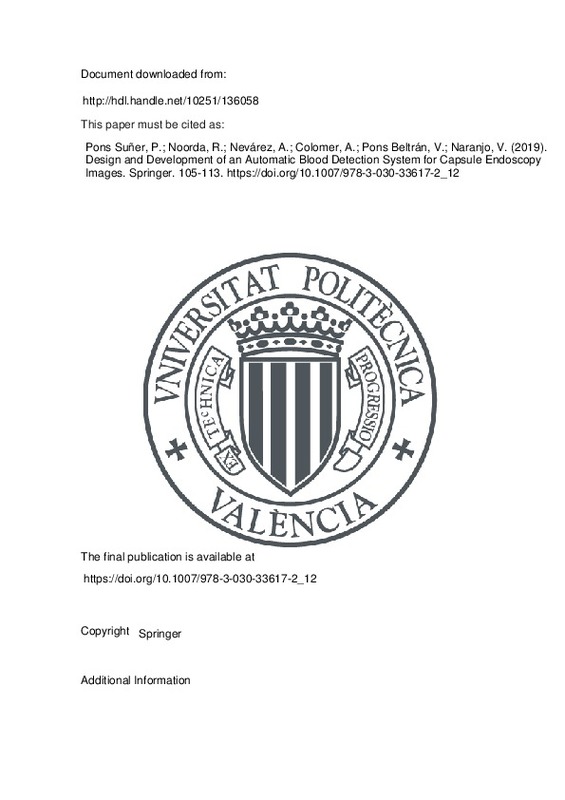JavaScript is disabled for your browser. Some features of this site may not work without it.
Buscar en RiuNet
Listar
Mi cuenta
Estadísticas
Ayuda RiuNet
Admin. UPV
Design and Development of an Automatic Blood Detection System for Capsule Endoscopy Images
Mostrar el registro sencillo del ítem
Ficheros en el ítem
| dc.contributor.author | Pons Suñer, Pedro
|
es_ES |
| dc.contributor.author | Noorda, Reinier
|
es_ES |
| dc.contributor.author | Nevárez, Andrea
|
es_ES |
| dc.contributor.author | Colomer, Adrián
|
es_ES |
| dc.contributor.author | Pons Beltrán, Vicente
|
es_ES |
| dc.contributor.author | Naranjo, Valery
|
es_ES |
| dc.date.accessioned | 2020-01-30T08:32:55Z | |
| dc.date.available | 2020-01-30T08:32:55Z | |
| dc.date.issued | 2019-10-18 | |
| dc.identifier.isbn | 978-3-030-33616-5 | |
| dc.identifier.issn | 0302-9743 | |
| dc.identifier.uri | http://hdl.handle.net/10251/136058 | |
| dc.description.abstract | Wireless Capsule Endoscopy is a technique that allows for observation of the entire gastrointestinal tract in an easy and non-invasive way. However, its greatest limitation lies in the time required to analyze the large number of images generated in each examination for diagnosis, which is about 2 hours. This causes not only a high cost, but also a high probability of a wrong diagnosis due to the physician’s fatigue, while the variable appearance of abnormalities requires continuous concentration. In this work, we designed and developed a system capable of automatically detecting blood based on classification of extracted regions, following two different classification approaches. The first method consisted in extraction of hand-crafted features that were used to train machine learning algorithms, specifically Support Vector Machines and Random Forest, to create models for classifying images as healthy tissue or blood. The second method consisted in applying deep learning techniques, concretely convolutional neural networks, capable of extracting the relevant features of the image by themselves. The best results (95.7% sensitivity and 92.3% specificity) were obtained for a Random Forest model trained with features extracted from the histograms of the three HSV color space channels. For both methods we extracted square patches of several sizes using a sliding window, while for the first approach we also implemented the waterpixels technique in order to improve the classification results | es_ES |
| dc.description.sponsorship | This work was funded by the European Unions H2020: MSCA: ITN program for the “Wireless In-body Environment Communication WiBEC” project under the grant agreement no. 675353. Additionally, we gratefully acknowledge the support of NVIDIA Corporation with the donation of the Titan V GPU used for this research. | es_ES |
| dc.format.extent | 8 | es_ES |
| dc.language | Inglés | es_ES |
| dc.publisher | Springer | es_ES |
| dc.relation.ispartof | Lecture Notes in Artificial Intelligence | |
| dc.rights | Reserva de todos los derechos | es_ES |
| dc.subject | Wireless Capsule Endoscopy | es_ES |
| dc.subject | Blood detection | es_ES |
| dc.subject | Machine Learning | es_ES |
| dc.subject | Hand-crafted feature | es_ES |
| dc.subject | Deep Learning | es_ES |
| dc.subject | Convolutional neural network | es_ES |
| dc.title | Design and Development of an Automatic Blood Detection System for Capsule Endoscopy Images | es_ES |
| dc.type | Capítulo de libro | es_ES |
| dc.type | Comunicación en congreso | es_ES |
| dc.identifier.doi | 10.1007/978-3-030-33617-2_12 | |
| dc.relation.projectID | info:eu-repo/grantAgreement/EC/H2020/675353/EU/Wireless In-Body Environment/ | es_ES |
| dc.rights.accessRights | Abierto | es_ES |
| dc.contributor.affiliation | Universitat Politècnica de València. Instituto Universitario de Telecomunicación y Aplicaciones Multimedia - Institut Universitari de Telecomunicacions i Aplicacions Multimèdia | es_ES |
| dc.description.bibliographicCitation | Pons Suñer, P.; Noorda, R.; Nevárez, A.; Colomer, A.; Pons Beltrán, V.; Naranjo, V. (2019). Design and Development of an Automatic Blood Detection System for Capsule Endoscopy Images. En Lecture Notes in Artificial Intelligence. Springer. 105-113. https://doi.org/10.1007/978-3-030-33617-2_12 | es_ES |
| dc.description.accrualMethod | S | es_ES |
| dc.relation.conferencename | International Conference on Intelligent Data Engineering and Automated Learning (IDEAL) | es_ES |
| dc.relation.conferencedate | Noviembre 14-16,2019 | es_ES |
| dc.relation.conferenceplace | Manchester, UK | es_ES |
| dc.relation.publisherversion | https://doi.org/10.1007/978-3-030-33617-2_12 | es_ES |
| dc.description.upvformatpinicio | 105 | es_ES |
| dc.description.upvformatpfin | 113 | es_ES |
| dc.type.version | info:eu-repo/semantics/publishedVersion | es_ES |
| dc.relation.pasarela | S\397467 | es_ES |
| dc.contributor.funder | European Commission | es_ES |
| dc.description.references | Berens, J., Finlayson, G.D., Qiu, G.: Image indexing using compressed colour histograms. IEE Proc. Vis., Image Signal Process. 147(4), 349–355 (2000). https://doi.org/10.1049/ip-vis:20000630 | es_ES |
| dc.description.references | Breiman, L.: Random forests. Mach. Learn. 45(1), 5–32 (2001). https://doi.org/10.1023/A:1010933404324 | es_ES |
| dc.description.references | Buscaglia, J.M., et al.: Performance characteristics of the suspected blood indicator feature in capsule endoscopy according to indication for study. Clin. Gastroenterol. Hepatol. 6(3), 298–301 (2008). https://doi.org/10.1016/j.cgh.2007.12.029 | es_ES |
| dc.description.references | Cortes, C., Vapnik, V.: Support-vector networks. Mach. Learn. 20(3), 273–297 (1995). https://doi.org/10.1007/BF00994018 | es_ES |
| dc.description.references | Li, B., Meng, M.Q.H.: Computer-aided detection of bleeding regions for capsule endoscopy images. IEEE Trans. Biomed. Eng. 56(4), 1032–1039 (2009). https://doi.org/10.1109/TBME.2008.2010526 | es_ES |
| dc.description.references | Machairas, V., Faessel, M., Cárdenas-Peña, D., Chabardes, T., Walter, T., Decencière, E.: Waterpixels. IEEE Trans. Image Process. 24(11), 3707–3716 (2015). https://doi.org/10.1109/TIP.2015.2451011 | es_ES |
| dc.description.references | Novozámskỳ, A., Flusser, J., Tachecí, I., Sulík, L., Bureš, J., Krejcar, O.: Automatic blood detection in capsule endoscopy video. J. Biomed. Opt. 21(12), 126007 (2016). https://doi.org/10.1117/1.JBO.21.12.126007 | es_ES |
| dc.description.references | Signorelli, C., Villa, F., Rondonotti, E., Abbiati, C., Beccari, G., de Franchis, R.: Sensitivity and specificity of the suspected blood identification system in video capsule enteroscopy. Endoscopy 37(12), 1170–1173 (2005). https://doi.org/10.1055/s-2005-870410 | es_ES |
| dc.description.references | Simonyan, K., Zisserman, A.: Very deep convolutional networks for large-scale image recognition. arXiv preprint arXiv:1409.1556 (2014) | es_ES |
| dc.description.references | Varma, S., Simon, R.: Bias in error estimation when using cross-validation for model selection. BMC Bioinform. 7(1), 91 (2006). https://doi.org/10.1186/1471-2105-7-91 | es_ES |







![[Cerrado]](/themes/UPV/images/candado.png)

